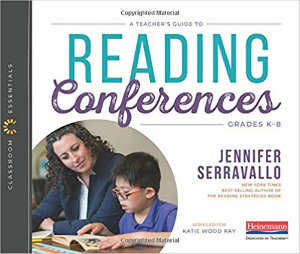A Super Guide to Quality Reading Conferences
A Teacher’s Guide to Reading Conferences (Grades K-8)
By Jennifer Serravallo
(Heinemann, 2019 – Learn more)

If you are a reading teacher, a curriculum coach, or a school leader, order a copy of A Teacher’s Guide to Reading Conferences right now. It is a must-have resource for anyone who wants to up their teaching and learning game during independent reading time. The entire book is dedicated to helping teachers have quality conferences with readers.
Independent Reading at Its Best

- a social component (ie: talking about texts);
- a modicum of accountability (ie: talking to a teacher about texts); and
- micro-teaching using students’ chosen texts as an anchor (ie: one-on-one mini lessons).
The problem is that while it’s easy to tell teachers to embed those structures, it is really challenging to actually do it. Getting independent reading in place is the easy part. The hard part is helping teachers see how to confer with students in meaningful ways that add to the independent reading experience.
Well, it was hard. Until this book.
Putting It All Together
Serravallo has a gift. This book, like the last book of hers I reviewed, Understanding Texts & Readers: Responsive Comprehension Instruction with Leveled Texts, doesn’t so much offer new information as organize what many reading teachers know but cannot quite figure out how to put together. Serravallo puts it all together for us.
She clearly has a big-picture vision and an organized mind that can take a million parts and pieces and put them together in a cohesive whole that makes sense and seems totally doable. She writes, “I’m the daughter of an analytical chemist and it’s an understatement to say I’ve got a brain that thrives on organization and structure” (p. 99). She shares that organization freely. What a gift to all of us.
Seven Great Chapters
The book is divided into seven chapters. Each offers an overview, an example, and tools and resources surrounding an aspect of engaging in reading conferences with K-8 students.
Chapter 1 – Getting Your Classroom Conferring Ready: “Conferring is where the magic happens. It is the heartbeat of the literacy block” (p. 1.) In this chapter, Serravallo sets the foundation for the book, offering the why’s, what’s, and how’s of conferring as a part of reading instruction.
She offers tips for time management, setting up your physical space for conferring, and keeping the rest of the students engaged when it is not their turn to confer with the teacher. Just in case you’re wondering, her tip for that is to have them READ! No fancy activities, no worksheets, no tests, just reading.
Chapter 2 – Understanding What Readers Know and Need: “The first step to make conferring feel more doable for you, and to maximize its usefulness for students, is to make sure it’s purposeful” (p. 13). In all of Serravallo’s books she shares her “Hierarchy of Reading Goals,” and this book is no exception.
Chapter two helps teachers use “assessment conferences” to determine what goals and accompanying skills and strategies a student needs to move forward. She also offers tips for when the teacher hasn’t read the book a given student is reading. This is important, as it is another frequent concern that teachers share.
Chapter 3 – Setting Goals: “Guiding students to set meaningful, ambitious goals begins with teachers inviting readers to reflect on their work, their strengths, and where they can grow” (p. 32). Once a teacher and a student have participated in one or more assessment conferences, it’s time to do a goal-setting conference where they collaboratively develop a goal. Serravallo offers step-by-step examples of the process as well as many examples of actual student goals.
Chapter 4 – Noticing and Naming Strengths: “…positive feedback should be focused on effort, rather than ability” (p. 48). This short chapter helps teachers learn to use what she calls compliment conferences to give praise that motivates students and promotes a growth mindset.
Serravallo advises that focusing on and building from strengths is a good approach, but that we must be mindful to be specific and observation-focused, and praise effort over ability, staying away from words like “good.” For example, instead of saying, “You’re a good reader!” try noticing something specific: “Your use of rereading helped you understand the text! It was nice to see!”
Chapter 5 – Teaching Strategies to Individuals and Groups: “As students work on their goals, they’ll need guided practice with strategies” (p. 57). The way to move students closer to their goals, says Serravallo, is to teach students skills and strategies during coaching conferences, research-compliment-teach conferences, or small or whole group strategy lessons that are later followed up with individual readers. To help teachers, she offers, as always, ample examples and tools for teaching.
Chapter 6 – Supporting Conversation and Collaboration: “Book clues and partnerships offer students an important chance to meet with peers, which makes reading more social” (p. 85). Reading is inherently social. We want to talk about what we read. Serravallo harnesses that drive and offers strategies to help teachers enable their students to collaborate to understand and enjoy texts in pairs and groups.
Chapter 7 – Planning and Managing Conferring Time: “You’ll be choosing your conference type to match your purpose and the kind of support a student needs” (p. 105). In chapter seven Serravallo concedes that the idea of conferring might be overwhelming to teachers. She then offers practical strategies for taming the beast, putting it all together, and making it work.
But There’s More!
The book comes with a code. And with that code you can access an online warehouse full of tools and resources that augment the book in powerful ways. Not only can you watch video clips of Seravallo conducting real-life student reading conferences, but you can read the transcripts of her conversations, download all of her forms, and access teaching plans. It is a treasure trove.
Equally compelling are the short bonus pages between each chapter. They include synopses of “Mentor Texts” (great books about reading instruction that have helped Serravallo hone her craft) and interviews with literacy leaders who have inspired her. Many of the greats in literacy instruction are honored, including Richard Allington, Lucy Calkins, Mari Clay, Peter Johnston, John Hattie, and Ellin Keene. Truly, I found the short summaries and interviews inspirational — they pumped me up for the next chapter to come.
You Need This Book
I have already recommended A Teacher’s Guide to Reading Conferences to every reading teacher in my school and district. I am confident that it will move our already strong independent reading program to a more effective place. I sincerely hope that this book finds its way into the hands of reading teachers of kids of all ages.
Rita Platt (@ritaplatt) is a National Board Certified Teacher with master’s degrees in reading, library, and leadership. Her experience includes teaching learners in remote Alaskan villages, inner cities, and rural communities. She currently is a school principal, teaches graduate courses for the Professional Development Institute and blogs at Heart of the School for MiddleWeb. Her book, Working Hard, Working Happy: Cultivating a Culture of Effort and Joy in the Classroom, launched in early July.






























